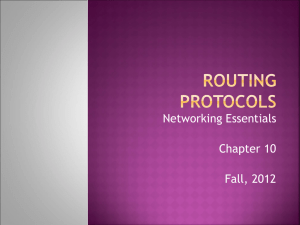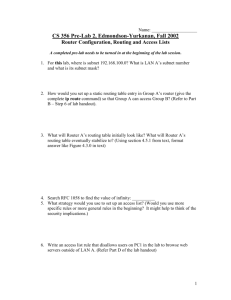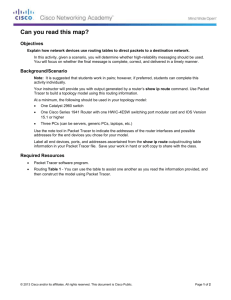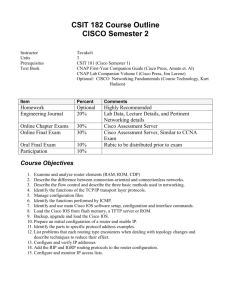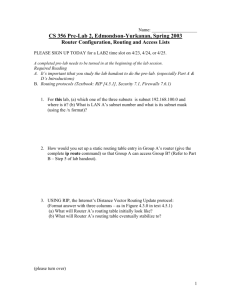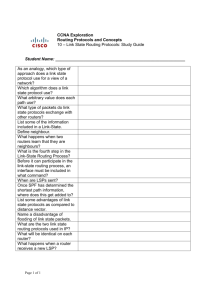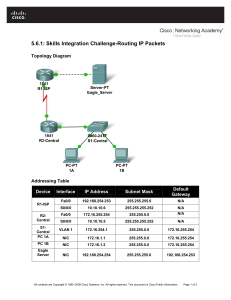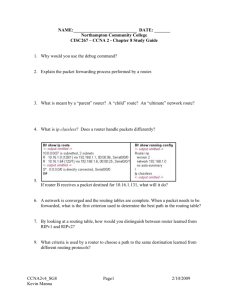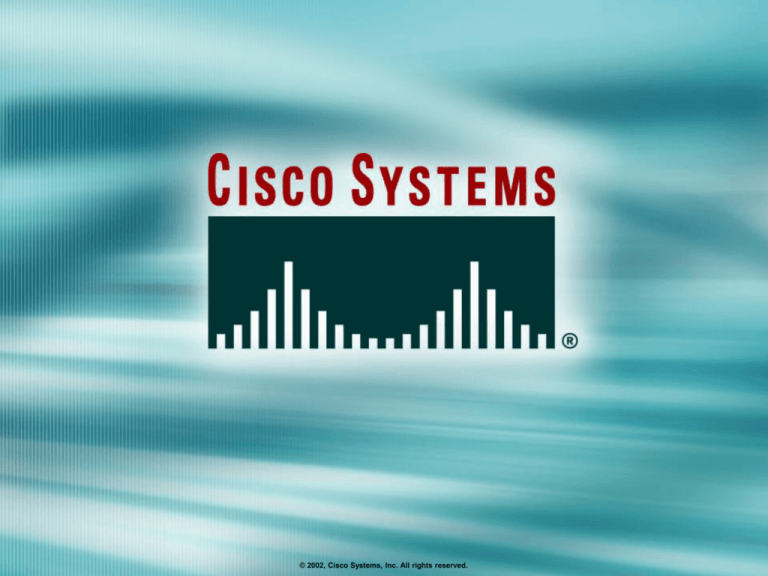
© 2002, Cisco Systems, Inc. All rights reserved.
Determining IP Routes
Module 5
© 2002, Cisco Systems, Inc. All rights reserved.
2
Objectives
Upon completing this lesson, you will be able to:
• Describe the features and operation of static routing
• Describe the features and operation of dynamic routing
protocols, including RIP, IGRP, EIGRP,
and OSPF
• Build a functional router configuration to support the
specified network operational requirements, given a
network design
• Use show commands to identify anomalies in routing
operation, given an operational router
• Use debug commands to identify events and anomalies in
routing operation, given an operational router
© 2002, Cisco Systems, Inc. All rights reserved.
ICND v2.0—5-3
Routing Overview
©©2002,
2002,Cisco
CiscoSystems,
Systems,Inc.
Inc.All
Allrights
rightsreserved.
reserved.
ICND v2.0—5-4
4
Objectives
Upon completing this lesson, you will be able to:
• Explain the differences between static routing and
dynamic routing
• Identify the classes of routing protocols
• Use Cisco IOS commands to configure static routes and
default route forwarding, given a functioning router
• Use show commands to identify anomalies in static
routing operation, given an operational router
• Describe the operation of “router on a stick”
• Configure router on a stick for inter-VLAN routing using
ISL and 802.1Q trunking, given an operational switch and
router
© 2002, Cisco Systems, Inc. All rights reserved.
ICND v2.0—5-5
What Is Routing?
To route, a router needs to do the following:
• Know the destination address
• Identify the sources it can learn from
• Discover possible routes
• Select the best route
• Maintain and verify routing information
© 2002, Cisco Systems, Inc. All rights reserved.
ICND v2.0—5-6
What Is Routing? (Cont.)
• Routers must learn destinations that are
not directly connected.
© 2002, Cisco Systems, Inc. All rights reserved.
ICND v2.0—5-7
Identifying Static and Dynamic Routes
Static Route
• Uses a route that a
network administrator
enters into the router
manually
© 2002, Cisco Systems, Inc. All rights reserved.
Dynamic Route
• Uses a route that a
network routing
protocol adjusts
automatically for
topology or traffic
changes
ICND v2.0—5-8
Static Routes
• Configure unidirectional static routes to and from
a stub network to allow communications to occur.
© 2002, Cisco Systems, Inc. All rights reserved.
ICND v2.0—5-9
Static Route Configuration
Router(config)#ip route network [mask]
{address | interface}[distance] [permanent]
• Defines a path to an IP destination network or subnet or host
© 2002, Cisco Systems, Inc. All rights reserved.
ICND v2.0—5-10
Static Route Example
• This is a unidirectional route. You must have a route
configured in the opposite direction.
© 2002, Cisco Systems, Inc. All rights reserved.
ICND v2.0—5-11
Default Routes
• This route allows the stub network to reach all known
networks beyond router A.
© 2002, Cisco Systems, Inc. All rights reserved.
ICND v2.0—5-12
Verifying the Static
Route Configuration
router#show ip route
Codes: C - connected, S - static, I - IGRP, R - RIP, M - mobile, B - BGP
D - EIGRP, EX - EIGRP external, O - OSPF, IA - OSPF inter area
E1 - OSPF external type 1, E2 - OSPF external type 2, E - EGP
i - IS-IS, L1 - IS-IS level-1, L2 - IS-IS level-2, * - candidate default
U - per-user static route
Gateway of last resort is 0.0.0.0 to network 0.0.0.0
C
S*
10.0.0.0/8 is subnetted, 1 subnets
10.1.1.0 is directly connected, Serial0
0.0.0.0/0 is directly connected, Serial0
© 2002, Cisco Systems, Inc. All rights reserved.
ICND v2.0—5-13
What Is a Routing Protocol?
• Routing protocols are
used between
routers to determine
paths and maintain
routing tables.
• Once the path is
determined, a router can
route a routed protocol.
© 2002, Cisco Systems, Inc. All rights reserved.
ICND v2.0—5-14
Autonomous Systems: Interior or
Exterior Routing Protocols
• An autonomous system is a collection of networks
under a common administrative domain.
• IGPs operate within an autonomous system.
• EGPs connect different autonomous systems.
© 2002, Cisco Systems, Inc. All rights reserved.
ICND v2.0—5-15
Administrative Distance:
Ranking Routes
© 2002, Cisco Systems, Inc. All rights reserved.
ICND v2.0—5-16
Classes of Routing Protocols
© 2002, Cisco Systems, Inc. All rights reserved.
ICND v2.0—5-17
Classful Routing Overview
• Classful routing protocols do not include the
subnet mask with the route advertisement.
• Within the same network, consistency of the
subnet masks is assumed.
• Summary routes are exchanged between foreign
networks.
• Examples of classful routing protocols:
– RIP Version 1 (RIPv1)
– IGRP
© 2002, Cisco Systems, Inc. All rights reserved.
ICND v2.0—5-18
Classless Routing Overview
• Classless routing protocols include the subnet mask
with the route advertisement.
• Classless routing protocols support variable-length
subnet masking (VLSM).
• Summary routes can be manually controlled within
the network.
• Examples of classless routing protocols:
– RIP Version 2 (RIPv2)
– EIGRP
– OSPF
– IS-IS
© 2002, Cisco Systems, Inc. All rights reserved.
ICND v2.0—5-19
Routing Protocol
Comparison Chart
© 2002, Cisco Systems, Inc. All rights reserved.
ICND v2.0—5-20
Using the ip classless Command
© 2002, Cisco Systems, Inc. All rights reserved.
ICND v2.0—5-21
VLAN-to-VLAN Overview
• Network layer devices combine multiple
broadcast domains.
© 2002, Cisco Systems, Inc. All rights reserved.
ICND v2.0—5-22
Dividing a Physical Interface into
Subinterfaces
• Physical interfaces can be divided into multiple
subinterfaces.
© 2002, Cisco Systems, Inc. All rights reserved.
ICND v2.0—5-23
Routing Between VLANs
with ISL Trunks
© 2002, Cisco Systems, Inc. All rights reserved.
ICND v2.0—5-24
Routing Between VLANs
with 802.1Q Trunks
© 2002, Cisco Systems, Inc. All rights reserved.
ICND v2.0—5-25
Summary
• Routing is the process by which an item gets from one
location to another. In networking, a router is the device
used to route traffic.
• Routers can forward packets over static routes or
dynamic routes, based on the router configuration.
• Static routes can be important if the Cisco IOS software
cannot build a route to a particular destination. Static
routes are also useful for specifying a “gateway of last
resort” to which all unroutable packets will be sent.
• A default route is a special type of static route used for
situations when the route from a source to a destination
is not known or when it is unfeasible for the routing table
to store sufficient information about the route.
© 2002, Cisco Systems, Inc. All rights reserved.
ICND v2.0—5-26
Summary (Cont.)
• When the static routing configuration is complete, use
the show ip route command to verify the configuration.
• Dynamic routing relies on a routing protocol to
disseminate knowledge. A routing protocol defines the
set of rules used by a router when it communicates with
neighboring routers.
• The ip classless command prevents a router from
dropping a packet destined for an unknown subnet.
• In a VLAN environment, frames are only switched
between ports within the same broadcast domain so a
Layer 3 device is required to enable inter-VLAN
communication. Use ISL or 802.1q to enable trunking on a
router’s subinterface.
© 2002, Cisco Systems, Inc. All rights reserved.
ICND v2.0—5-27

